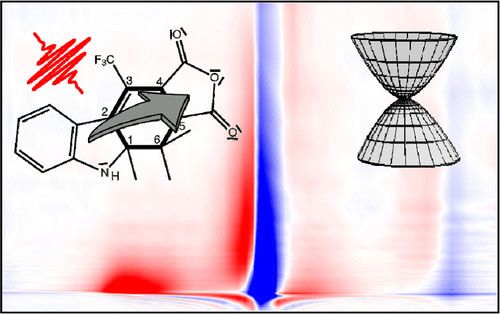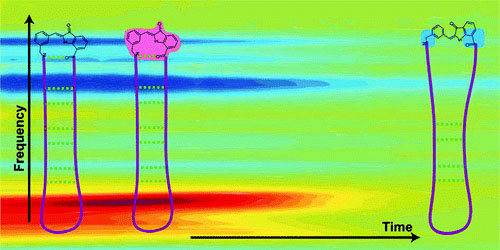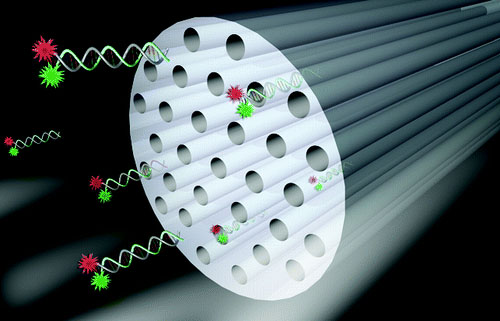Research Area A
Publications 2012
10-Dec-2012

A combination of experimental and theoretical techniques is used to study the photoinduced ring-opening/closure of a trifluoromethyl-indolylfulgide. Time-resolved UV/vis pump and IR probe measurements are performed in the subpicosecond to 50 ps time range. A combination of experimental and theoretical techniques is used to study the photoinduced ... READ MORE
13-Nov-2012

Two hemithioindigo–hemistilbene (HTI) derivatives, designed to operate as structural switches in peptides, as well as two HTI peptides are characterized by ultrafast spectroscopy in the visible and the infrared. The two HTI switches follow the reaction scheme published for other HTI compounds with a picosecond excited state reaction (τ₁ ≈ 6 ps) and ... READ MORE
Synchronous Emission from Nanometric Silver Particles through Plasmonic Coupling on Silver Nanowires
07-Sep-2012

We investigated silver nanowires using correlative wide-field fluorescence and transmission electron microscopy. In the wide-field fluorescence images, synchronous emission from different distinct positions along the silver nanowires was observed. The sites of emission were separated spatially by up to several micrometers. Nanowires emitting in such cooperative ... READ MORE
01-Aug-2012
The unusual cyclin-dependent protein kinase 5 (CDK5) was discovered based on its sequence homology to cell cycle regulating CDKs. CDK5 was found to be active in brain tissues, where it is not involved in cell cycle regulation but in the regulation of neuronal cell differentiation and neurocytoskeleton dynamics. An aberrant regulation of CDK5 leads to the development ... READ MORE
01-Aug-2012
Useful diversity: Quantification of modified tRNA nucleobases in different murine and porcine tissues reveals a tissue-specific overall modification content. The modification content correlates with rates of protein synthesis in vitro, suggesting a direct link between tRNA modification levels and tissue-specific translational efficiency. ... READ MORE
01-Aug-2012

Eraserhead: Stem cells seem to erase epigenetic information by decarboxylation of the newly discovered epigenetic base 5-carboxycytosine (caC; see picture). This reaction is likely to involve a nucleophilic attack of the C5-C6 double bond.
... READ MORE01-Aug-2012
Bacterial spores possess an enormous resistance to ultraviolet (UV) radiation. This is largely due to a unique DNA repair enzyme, Spore Photoproduct Lyase (SP lyase) that repairs a specific UV-induced DNA lesion, the spore photoproduct (SP), through an unprecedented radical-based mechanism. Unlike DNA photolyases, SP lyase belongs to the emerging superfamily of ... READ MORE
01-Aug-2012
The photophysical and photochemical processes driving the formation of the ultraviolet (UV)-induced DNA Dewar lesion from the T(6-4)T dimer are investigated by time-resolved spectroscopy and quantum chemical modelling. Time-resolved absorption and emission spectroscopy in the UV revealed a biexponential decay of the electronically excited state (S1) with time ... READ MORE
01-Aug-2012
The light-driven disassembly process of amyloid-like structures formed by azobenzene model peptides is studied by time-resolved mid-IR spectroscopy from nanoseconds to minutes. The investigated peptide consists of two amino acid strands connected by the azobenzene switch. The peptides aggregate to amyloid-like structures when the azobenzene chromophore is in the ... READ MORE
01-Aug-2012
Rugulactone is a dihydro-α-pyrone isolated from the plant Cryptocarya rugulosa in 2009. It has been reported to display IkB kinase (IKK) inhibitory activity, as well as antibiotic activity in several strains of pathogenic bacteria. However, its biological targets and mode of action in bacteria have not yet been explored. Here we present enantioselective syntheses of ... READ MORE
15-May-2012
Different bioactive molecules are released into living cells from lipid-covered mesoporous silica nanoparticles. The release is triggered by light, as the particles feature covalently attached photosensitizers as membrane-opening agents. It is demonstrated that the particles achieve endosomal escape and that they release their cargo into the cytosol. ... READ MORE
29-Mar-2012

The diffusion dynamics of terrylene diimide (TDI) dye molecules and dye-labeled double-strand DNA were studied in micrometer long silica filaments containing collinear, oriented mesopores using single molecule fluorescence microscopy. TDI was used as a stable and hydrophobic probe molecule for single molecule structural analysis. We used template-free mesoporous ... READ MORE
02-Mar-2012
5-Methylcytosine (5mC) in genomic DNA has important epigenetic functions in embryonic development and tumor biology. 5-Hydroxymethylcytosine (5hmC) is generated from 5mC by the action of the TET (Ten-Eleven-Translocation) enzymes and may be an intermediate to further oxidation and finally demethylation of 5mC. We have used immunohistochemistry (IHC) and isotope-based ... READ MORE
23-Jan-2012
A novel synthesis method for large-pore, well-aligned 2D hexagonal mesoporous silica thin films is reported. The alignment was achieved by confinement in poly(dimethylsiloxane) (PDMS) microgrooves without the necessity of additional forces (such as electric fields). We describe the influence of various experimental conditions including the way the grooves are filled, ... READ MORE
11-Jan-2012
Oligonucleotides used in gene therapy and silencing are fragile compounds that degrade easily in biological environments. Porous biocompatible carrier particles may provide a useful strategy to deliver these therapeutics to their target sites. Development of appropriate delivery vehicles, however, requires a better understanding of the oligonucleotide-host ... READ MORE
18-Oct-2011
To prove the ergodic theorem experimentally the diffusivities of guest molecules inside a nanostructured porous glass were measured by using two conceptually different approaches under identical conditions. The data obtained through the direct observation of dye-molecule diffusion by single-molecule tracking experiments (red circles) was in perfect agreement with the ... READ MORE


